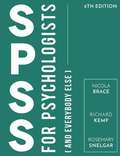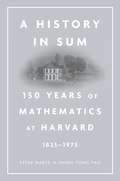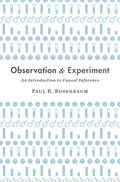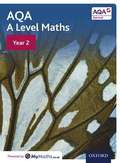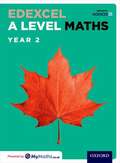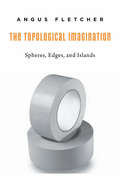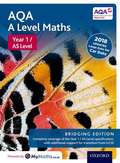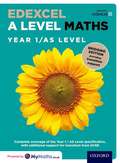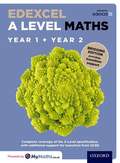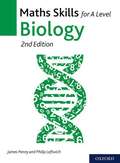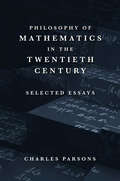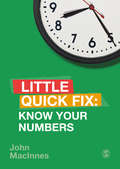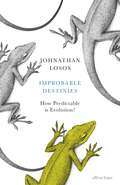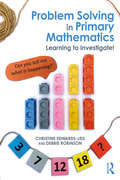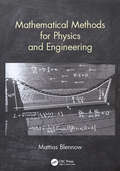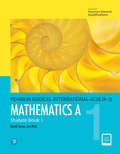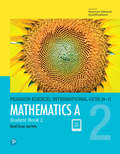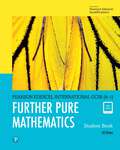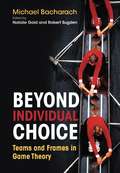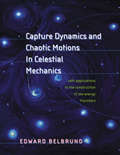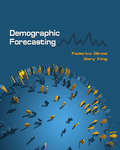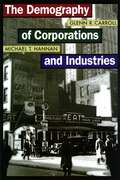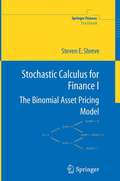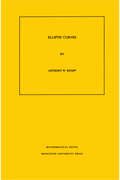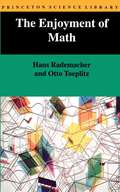- Table View
- List View
Spss For Psychologists: And Everybody Else (PDF)
by Nicola Brace Rosemary Snelgar Richard KempPsychology students can find statistical analysis a challenging and complex task and, in order to master the techniques and complete their assignments and projects, they need to have a sound understanding of IBM SPSS. This practical book is designed to introduce students to SPSS in an accessible yet rigorous way, so that they can feel confident with a variety of essential tasks: from data entry to completing a t-test in statistical analyses you need for your course or research. With handy screenshots throughout, students are guided through the process from start to finish. This ‘end to end’ approach will enable both undergraduate psychology students and those more experienced in statistical analysis to get started and then master this powerful software tool.
A History in Sum: 150 Years Of Mathematics At Harvard, 1825-1975
by Steve NadisIn the twentieth century, American mathematicians began to make critical advances in a field previously dominated by Europeans. Harvard's mathematics department was at the center of these developments. A History in Sum is an inviting account of the pioneers who trailblazed a distinctly American tradition of mathematics--in algebraic geometry, complex analysis, and other esoteric subdisciplines that are rarely written about outside of journal articles or advanced textbooks. The heady mathematical concepts that emerged, and the men and women who shaped them, are described here in lively, accessible prose. The story begins in 1825, when a precocious sixteen-year-old freshman, Benjamin Peirce, arrived at the College. He would become the first American to produce original mathematics--an ambition frowned upon in an era when professors largely limited themselves to teaching. Peirce's successors transformed the math department into a world-class research center, attracting to the faculty such luminaries as George David Birkhoff. Influential figures soon flocked to Harvard, some overcoming great challenges to pursue their elected calling. A History in Sum elucidates the contributions of these extraordinary minds and makes clear why the history of the Harvard mathematics department is an essential part of the history of mathematics in America and beyond.
Observation and Experiment: An Introduction to Causal Inference
by Paul R. RosenbaumIn the face of conflicting claims about some treatments, behaviors, and policies, the question arises: What is the most scientifically rigorous way to draw conclusions about cause and effect in the study of humans? In this introduction to causal inference, Paul Rosenbaum explains key concepts and methods through real-world examples.
Aqa A Level Maths: Year 2 Student Book
by Paul Williams Robert Wagner David Baker Brian Jefferson Garry Wiseman Mark Rowland John Rayneau Eddie Mullan Katie WoodThis Student Book provides full support for year two of an AQA A Level course. Covering all the pure maths, mechanics and statistics content needed, the book provides dedicated exercises in every chapter for exam-style problem-solving and modelling questions. Dedicated revision exercises test synoptically across the curriculum. Throughout the book, the explanatory text is clear and concise, with abundant worked examples to show how key techniques can be used andcommon pitfalls to avoid. Short answers are in the back of the book, while full step-by-step solutions are provided online. MyMaths links appear at the bottom of all exercises, providing a quick route to further practice and support.
Edexcel A Level Maths: Year 2 Student Book
by Paul Williams Robert Wagner David Baker Brian Jefferson Garry Wiseman Mark Rowland David Bowles Mike Heylings John Rayneau Eddie Mullan Katie WoodPlease note this title is suitable for any student studying:-----This Student Book provides full support for year two of the Edexcel A Level course, matching the new specification. Covering all the pure maths, mechanics and statistics content needed, the book provides dedicated exercises in every chapter for exam-style problem-solving and modelling questions. Dedicatedrevision exercises test synoptically across the curriculum. Throughout the book, the explanatory text is clear and concise, with abundant worked examples to show how key techniques can be used andcommon pitfalls to avoid. Short answers are in the back of the book, while full step-by-step solutions are provided online. MyMaths links appear at the bottom of all exercises, providing a quick route to further practice and support.
The Topological Imagination: Spheres, Edges, And Islands
by Angus FletcherIn a bold and boundary defining work, Angus Fletcher clears a space for an intellectual encounter with the shape of human imagining. Joining literature and topology—a branch of mathematics—he maps the ways the imagination’s contours are formed by the spherical earth’s patterns and cycles, and shows how the world we inhabit also inhabits us.
Aqa A Level Maths: A Level Aqa A Level Maths Year 1 Student Book: Bridging Edition
by David Bowles David Baker Brian Jefferson Eddie Mullan John Rayneau Mark Rowland Robert Wagner Paul Williams Garry Wiseman Katie WoodApproved by AQA, this Student Book provides full support for AS Level Maths and Year 1 of the full A Level (2017 specification). Bridging units at the start of each chapter provide the perfect springboard to support students in their transition from GCSE. Concise recap sections and abundant fluency-style questions ensure the whole class can be brought to the same level of readiness for A Level. The main chapters cover the full AS specification across pure, mechanics and statistics. Clear and concise explanations are supported by extensive worked examples showing key techniques and common pitfalls. For each topic, students can check their understanding with a fluency-style exercise before advancing to a dedicated problem-solving exercise. This book supports the major changes in assessment style for the 2017 specification, with an assessment at the end of each chapter written in the new exam style, and with revision exercises that test synoptically across the syllabus. The statistics content has been fully updated to support AQA's new 2018 Large data set (car data). Short answers are in the back of the book, while full step-by-step solutions are provided free online. MyMaths links appear at the bottom of all exercises, providing a quick route to further practice and support. Additional support is available online via Oxford's widely acclaimed Kerboodle platform.
Edexcel A Level Maths: A Level Edexcel A Level Maths Year 1 / As Level: Bridging Edition
by David Bowles Mike Heylings Brian Jefferson Eddie Mullan John Rayneau Robert Wagner Paul Williams Garry Wiseman Katie Wood David BakerEndorsed for Edexcel, this Student Book provides full support for AS Level Maths and Year 1 of the full A Level (2017 specification). Bridging units at the start of each chapter provide the perfect springboard to support students in their transition from GCSE. Concise recap sections and abundant fluency-style questions ensure the whole class can be brought to the same level of readiness for A Level. The main chapters cover the full AS specification across pure, mechanics and statistics. Clear and concise explanations are supported by extensive worked examples showing key techniques and common pitfalls. For each topic, students can check their understanding with a fluency-style exercise before advancing to a dedicated problem-solving exercise. This Student Book supports the major changes in assessment style for the 2017 specification, with an assessment at the end of each chapter written in the new exam style, and with revision exercises that test synoptically across the syllabus. Short answers are in the back of the book, while full step-by-step solutions are provided free online. MyMaths links appear at the bottom of all exercises, providing a quick route to further practice and support. Additional support is available online via Oxford's widely acclaimed Kerboodle platform.
Edexcel A Level Maths: A Level Edexcel A Level Maths Year 1 And 2 Combined Student Book: Bridging Edition
by Paul Williams Robert Wagner David Baker Brian Jefferson Garry Wiseman Mark Rowland David Bowles Mike Heylings John Rayneau Eddie Mullan Katie WoodEndorsed for Edexcel, this Student Book provides full support for A Level Maths (2017 specification). Bridging units at the start of each Year 1 chapter provide the perfect springboard to support students in their transition from GCSE. Concise recap sections and abundant fluency-style questions ensure the whole class can be brought to the same level of readiness for A Level. The main chapters cover the full specification across pure, mechanics and statistics. Clear and concise explanations are supported by extensive worked examples showing key techniques and common pitfalls. For each topic, students can check their understanding with a fluency-style exercise before advancing to a dedicated problem-solving exercise. This Student Book supports the major changes in assessment style for the 2017 specification, with an assessment at the end of each chapter written in the new exam style, and with revision exercises that test synoptically across the syllabus. The Year 2 calculus coverage has been updated to support Edexcel's new specification content (revised in 2018). Short answers are in the back of the book, while full step-by-step solutions are provided free online. MyMaths links appear at the bottom of all exercises, providing a quick route to further practice and support. Additional support is available online via Oxford's widely acclaimed Kerboodle platform.
Maths Skills For A Level Biology 2nd edition.pdf
by James Penny Philip LeftwichThe maths needed to succeed in A Level Science is harder now than ever before. Suitable for all awarding bodies, this practical handbook addresses all of the maths skills needed for A Level Biology specifications. Worked examples, practice questions, 'remember points' and 'stretch yourself' questions give students the key knowledge and then the opportunity to practise and build confidence.
Philosophy of Mathematics in the Twentieth Century: Selected Essays
by Charles ParsonsIn these selected essays, Charles Parsons surveys the contributions of philosophers and mathematicians who shaped the philosophy of mathematics over the past century: Brouwer, Hilbert, Bernays, Weyl, Gödel, Russell, Quine, Putnam, Wang, and Tait.
Know Your Numbers: Little Quick Fix (Little Quick Fix (PDF))
by Professor John MacInnesThe Know Your Numbers Little Quick Fix teaches students easy ways to nail the basic numbers, but also why it's important. Relationships between numbers are what underpins all quantitative research. This Little Quick Fix teaches them why it's fun, powerful, and definitely not scary, to see the world in numbers. Little Quick Fix titles provide quick but authoritative answers to the problems, hurdles, and assessment points students face in the research course, project proposal, or design—whatever their methods learning is. Lively, ultra-modern design; full-colour, each page a tailored design. An hour's read. Easy to dip in and out of with clear navigation enables the reader to find what she needs—quick. Direct written style gets to the point with clear language. Nothing needs to be read twice. No fluff. Learning is reinforced through a 2-minute overview summary; 3-second summaries with super-quick Q&A DIY tasks create a work plan to accomplish a task, do a self-check quiz, solve a problem, get students to what they need to show their supervisor. Checkpoints in each section make sure students are nailing it as they go and support self-directed learning. How do I know I’m done? Each Little Quick Fix wraps up with a finale checklist that allows the reader to self-assess they’ve got what they need to progress, submit, or ace the test or task.
Improbable Destinies: How Predictable is Evolution?
by Jonathan LososA dazzling tour of evolution in action that sheds light on one of the greatest debates in scienceThe natural world is full of fascinating instances of convergence: phenomena like eyes and wings and tree-climbing lizards that have evolved independently, multiple times. Convergence suggests that evolution is predictable, and if we could replay the tape of life, we would get the same outcome. But there are also many examples of contingency, cases where the tiniest change - a random mutation or an ancient butterfly sneeze - caused evolution to take a completely different course. So are we humans, and all the plants and animals in the world today, inevitabilities or evolutionary freaks? What role does chance play in evolution? And what could it tell us about life on other planets? In Improbable Destinies, renowned researcher Jonathan Losos reveals what the latest breakthroughs in evolutionary biology tell us about one of the greatest ongoing debates in science. Evolution can occur far more rapidly than Darwin expected, which has opened the door to something that was previously thought impossible: experimental studies of evolution in nature. Drawing on his own work with anole lizards on the Caribbean islands, as well as studies of guppies, foxes, field mice and others being conducted around the world, Losos reveals just how rapid and predictable evolution can be. By charting the discoveries of the scientists who are rewriting our understanding of evolutionary biology, Improbable Destinies will change the way we think and talk about evolution.
Problem Solving in Primary Mathematics: Learning to Investigate!
by Christine Edwards-Leis Debbie RobinsonProblem Solving in Primary Mathematics is an essential text designed to support new and experienced teachers in guiding pupils through mathematical investigations and problem solving, offering a framework that children themselves can begin to adopt as they progress to greater metacognitive awareness. Underpinned by the latest international research and theory, it examines how individual pupils think and act differently and offers guidance on how to promote independence and autonomy in the classroom. It examines key topics such as: Preparing for mathematical learning Designing learning material Assessing and evaluating learning Identifying key points for intervention What to do when learning is stalled Critical numeracy for real-world problem solving Mental Model Theory and the Mental Model Mode Different approaches to problem solving and investigating Aimed at new and experienced educators, particularly those with a maths specialism, and illustrated with investigations and activities, Problem Solving in Primary Mathematics demonstrates how frameworks can be used in key mathematical areas and assists students in progressing towards more meaningful problem solving.
Mathematical Methods for Physics and Engineering
by Mattias BlennowSuitable for advanced undergraduate and graduate students, this new textbook contains an introduction to the mathematical concepts used in physics and engineering. The entire book is unique in that it draws upon applications from physics, rather than mathematical examples, to ensure students are fully equipped with the tools they need. This approach prepares the reader for advanced topics, such as quantum mechanics and general relativity, while offering examples, problems, and insights into classical physics. The book is also distinctive in the coverage it devotes to modelling, and to oft-neglected topics such as Green's functions.
Edexcel International GCSE: Print And Ebook Bundle (Edexcel International GCSE)
by I A Potts D A TurnerPearson Edexcel International GCSE (9–1) Mathematics A prepares students for the new 2016 International GCSE (9–1) Mathematics A specification. Together, Student Books 1 and 2 provide comprehensive coverage of the Higher Tier specification. This book is designed to provide students with the best preparation possible for the examination: Written by highly experienced International GCSE Mathematics teachers and authors David Turner and Ian Potts Integrated exam practice throughout, with differentiated revision exercises, exam practice and learning summary sections Signposted transferable skills Integrated Pearson Progression Scale Reviewed by a language specialist to ensure the book is written in a clear and accessible style for students whose first language may not be English Glossary of key Mathematics terminology, along with full answers included in the back of the book Free eBook included Interactive practice activities and teacher support provided online as part of Pearson’s ActiveLearn Digital Service.
Mathematics A (Edexcel International GCSE)
by D. A. Turner I. A. PottsEdexcel International GCSE (9-1) Mathematics A prepares students for the new 2016 International GCSE (9-1) Mathematics A specification. Together, Student Books 1 and 2 provide comprehensive coverage of the Higher Tier specification. This book, which includes access to the eBook, is designed to provide students with the best preparation possible for the examination: Written by highly experienced International GCSE Mathematics teachers and authors David Turner and Ian Potts Integrated exam practice throughout, with differentiated revision exercises, exam practice and learning summary sections Signposted transferable skills Integrated Pearson Progression Scale Reviewed by a language specialist to ensure the book is written in a clear and accessible style for students whose first language may not be English Glossary of key Mathematics terminology, along with full answers included in the back of the book Free eBook included Interactive practice activities and teacher support provided online as part of Pearson's ActiveLearn Digital Service.
Edexcel International Gcse (Edexcel International GCSE)
by Ali DatooEdexcel International GCSE (9-1) Further Pure Mathematics Student Book provides comprehensive coverage of the new specification and is designed to supply students with the best preparation possible for the examination. These new resource also have progression, international relevance and support at their core. Integrated exam practice throughout, with differentiated revision exercises, exam practice and learning summary sections. Provides free access to an ActiveBook, a digital version of the Student Book, which can be accessed online, anytime, anywhere supporting learning beyond the classroom. Transferable skills, needed for progression into higher education and employment, are signposted allowing students to understand, and engage with, the skills they're gaining. A fully integrated Progression Map tool allows quick and easy formative assessment of student progress, linked to guidance on how to personalise learning solutions. Reviewed by a language specialist to ensure the book is written in a clear and accessible style for students whose first language may not be English. Glossary of key terminology. Online teacher support materials. Available: August-September 2017
Beyond Individual Choice: Teams and Frames in Game Theory (PDF)
by Michael Bacharach Natalie Gold Robert SugdenGame theory is central to modern understandings of how people deal with problems of coordination and cooperation. Yet, ironically, it cannot give a straightforward explanation of some of the simplest forms of human coordination and cooperation--most famously, that people can use the apparently arbitrary features of "focal points" to solve coordination problems, and that people sometimes cooperate in "prisoner's dilemmas." Addressing a wide readership of economists, sociologists, psychologists, and philosophers, Michael Bacharach here proposes a revision of game theory that resolves these long-standing problems. In the classical tradition of game theory, Bacharach models human beings as rational actors, but he revises the standard definition of rationality to incorporate two major new ideas. He enlarges the model of a game so that it includes the ways agents describe to themselves (or "frame") their decision problems. And he allows the possibility that people reason as members of groups (or "teams"), each taking herself to have reason to perform her component of the combination of actions that best achieves the group's common goal. Bacharach shows that certain tendencies for individuals to engage in team reasoning are consistent with recent findings in social psychology and evolutionary biology. As the culmination of Bacharach's long-standing program of pathbreaking work on the foundations of game theory, this book has been eagerly awaited. Following Bacharach's premature death, Natalie Gold and Robert Sugden edited the unfinished work and added two substantial chapters that allow the book to be read as a coherent whole.
Capture Dynamics and Chaotic Motions in Celestial Mechanics: With Applications to the Construction of Low Energy Transfers (PDF)
by Edward BelbrunoThis book describes a revolutionary new approach to determining low energy routes for spacecraft and comets by exploiting regions in space where motion is very sensitive (or chaotic). It also represents an ideal introductory text to celestial mechanics, dynamical systems, and dynamical astronomy. Bringing together wide-ranging research by others with his own original work, much of it new or previously unpublished, Edward Belbruno argues that regions supporting chaotic motions, termed weak stability boundaries, can be estimated. Although controversial until quite recently, this method was in fact first applied in 1991, when Belbruno used a new route developed from this theory to get a stray Japanese satellite back on course to the moon. This application provided a major verification of his theory, representing the first application of chaos to space travel. Since that time, the theory has been used in other space missions, and NASA is implementing new applications under Belbruno's direction. The use of invariant manifolds to find low energy orbits is another method here addressed. Recent work on estimating weak stability boundaries and related regions has also given mathematical insight into chaotic motion in the three-body problem. Belbruno further considers different capture and escape mechanisms, and resonance transitions. Providing a rigorous theoretical framework that incorporates both recent developments such as Aubrey-Mather theory and established fundamentals like Kolmogorov-Arnold-Moser theory, this book represents an indispensable resource for graduate students and researchers in the disciplines concerned as well as practitioners in fields such as aerospace engineering.
Demographic Forecasting (PDF)
by Federico Girosi Gary KingDemographic Forecasting introduces new statistical tools that can greatly improve forecasts of population death rates. Mortality forecasting is used in a wide variety of academic fields, and for policymaking in global health, social security and retirement planning, and other areas. Federico Girosi and Gary King provide an innovative framework for forecasting age-sex-country-cause-specific variables that makes it possible to incorporate more information than standard approaches. These new methods more generally make it possible to include different explanatory variables in a time-series regression for each cross section while still borrowing strength from one regression to improve the estimation of all. The authors show that many existing Bayesian models with explanatory variables use prior densities that incorrectly formalize prior knowledge, and they show how to avoid these problems. They also explain how to incorporate a great deal of demographic knowledge into models with many fewer adjustable parameters than classic Bayesian approaches, and develop models with Bayesian priors in the presence of partial prior ignorance. By showing how to include more information in statistical models, Demographic Forecasting carries broad statistical implications for social scientists, statisticians, demographers, public-health experts, policymakers, and industry analysts. Introduces methods to improve forecasts of mortality rates and similar variables Provides innovative tools for more effective statistical modeling Makes available free open-source software and replication data Includes full-color graphics, a complete glossary of symbols, a self-contained math refresher, and more
The Demography of Corporations and Industries (PDF)
by Glenn R. Carroll Michael T. HannanMost analysts of corporations and industries adopt the focal perspective of a single prototypical organization. Many analysts also study corporations primarily in terms of their internal organizational structures or as complex systems of financial contracts. Glenn Carroll and Michael Hannan bring fresh insight to our understanding of corporations and the industries they comprise by looking beyond prototypical structures to focus on the range and diversity of organizations in their social and economic setting. The result is a rich rendering of analysis that portrays whole populations and communities of corporations. The Demography of Corporations and Industries is the first book to present the demographic approach to organizational studies in its entirety. It examines the theory, models, methods, and data used in corporate demographic research. Carroll and Hannan explore the processes by which corporate populations change over time, including organizational founding, growth, decline, structural transformation, and mortality. They review and synthesize the major theoretical mechanisms of corporate demography, ranging from aging and size dependence to population segregation and density dependence. The book also explores some selected implications of corporate demography for public policy, including employment and regulation. In this path-breaking book, Carroll and Hannan demonstrate why demographic research on corporations is important; describe how to conduct demographic research; specify fruitful areas of future research; and suggest how the demographic perspective can enrich the public discussion of issues surrounding the corporation in our constantly evolving industrial society. All researchers and analysts with an interest in this topic will find The Demography of Corporations and Industries an invaluable resource.
Stochastic Calculus For Finance I: The Binomial Asset Pricing Model (PDF)
by Steven E. ShreveDeveloped for the professional Master's program in Computational Finance at Carnegie Mellon, the leading financial engineering program in the U.S. Has been tested in the classroom and revised over a period of several years. Exercises conclude every chapter; some of these extend the theory while others are drawn from practical problems in quantitative finance.
Elliptic Curves. (Mathematical Notes #40)
by Anthony W. KnappAn elliptic curve is a particular kind of cubic equation in two variables whose projective solutions form a group. Modular forms are analytic functions in the upper half plane with certain transformation laws and growth properties. The two subjects--elliptic curves and modular forms--come together in Eichler-Shimura theory, which constructs elliptic curves out of modular forms of a special kind. The converse, that all rational elliptic curves arise this way, is called the Taniyama-Weil Conjecture and is known to imply Fermat's Last Theorem. Elliptic curves and the modeular forms in the Eichler- Shimura theory both have associated L functions, and it is a consequence of the theory that the two kinds of L functions match. The theory covered by Anthony Knapp in this book is, therefore, a window into a broad expanse of mathematics--including class field theory, arithmetic algebraic geometry, and group representations--in which the concidence of L functions relates analysis and algebra in the most fundamental ways. Developing, with many examples, the elementary theory of elliptic curves, the book goes on to the subject of modular forms and the first connections with elliptic curves. The last two chapters concern Eichler-Shimura theory, which establishes a much deeper relationship between the two subjects. No other book in print treats the basic theory of elliptic curves with only undergraduate mathematics, and no other explains Eichler-Shimura theory in such an accessible manner.
The Enjoyment of Math (Princeton Science Library (PDF))
by Hans Rademacher Otto ToeplitzWhat is so special about the number 30? How many colors are needed to color a map? Do the prime numbers go on forever? Are there more whole numbers than even numbers? These and other mathematical puzzles are explored in this delightful book by two eminent mathematicians. Requiring no more background than plane geometry and elementary algebra, this book leads the reader into some of the most fundamental ideas of mathematics, the ideas that make the subject exciting and interesting. Explaining clearly how each problem has arisen and, in some cases, resolved, Hans Rademacher and Otto Toeplitz's deep curiosity for the subject and their outstanding pedagogical talents shine through.
